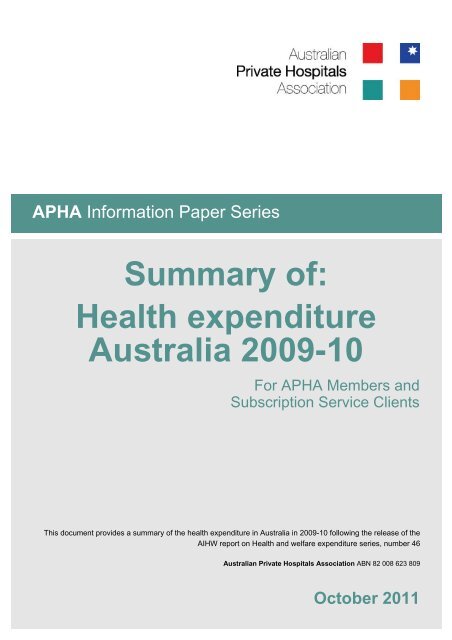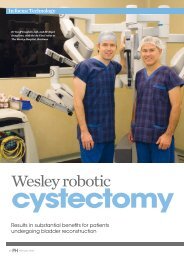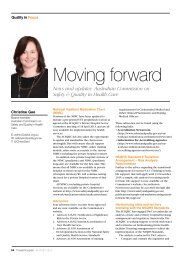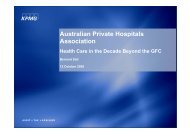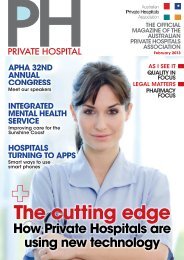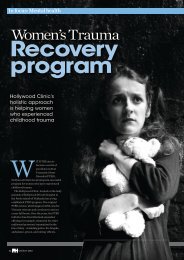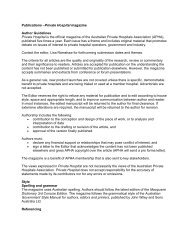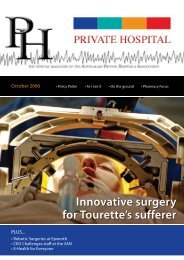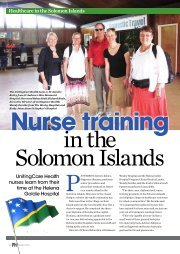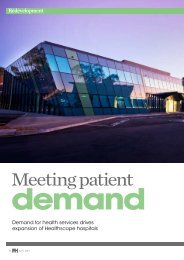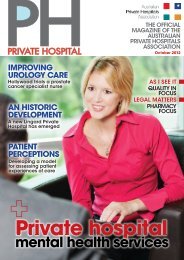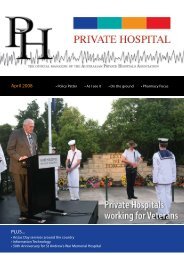Summary of: Health expenditure Australia 2009-10 - Australian ...
Summary of: Health expenditure Australia 2009-10 - Australian ...
Summary of: Health expenditure Australia 2009-10 - Australian ...
Create successful ePaper yourself
Turn your PDF publications into a flip-book with our unique Google optimized e-Paper software.
APHA Information Paper Series<br />
<strong>Summary</strong> <strong>of</strong>:<br />
<strong>Health</strong> <strong>expenditure</strong><br />
<strong>Australia</strong> <strong>2009</strong>-<strong>10</strong><br />
For APHA Members and<br />
Subscription Service Clients<br />
This document provides a summary <strong>of</strong> the health <strong>expenditure</strong> in <strong>Australia</strong> in <strong>2009</strong>-<strong>10</strong> following the release <strong>of</strong> the<br />
AIHW report on <strong>Health</strong> and welfare <strong>expenditure</strong> series, number 46<br />
<strong>Australia</strong>n Private Hospitals Association ABN 82 008 623 809<br />
October 2011
2 APHA Information Paper Series
Table <strong>of</strong> Contents<br />
1 Total health <strong>expenditure</strong> ..................................................................................................................................... 4<br />
2 Who pays Funding <strong>of</strong> health <strong>expenditure</strong> ......................................................................................................... 4<br />
3 <strong>Health</strong> <strong>expenditure</strong> and funding, by area <strong>of</strong> health <strong>expenditure</strong> ........................................................................ 5<br />
4 International comparisons ................................................................................................................................... 6<br />
5 Key Contacts ........................................................................................................................................................ 7<br />
3 APHA Information Paper Series
1 Total health <strong>expenditure</strong><br />
<br />
<br />
<br />
<br />
<br />
<br />
<br />
<br />
During <strong>2009</strong>‐<strong>10</strong>, <strong>Australia</strong> spent an estimated $121.4 billion on health goods and services. This was an<br />
increase <strong>of</strong> 7% or $7.9 billion (in terms <strong>of</strong> current prices 1 ) and 3.6% or $4.3 billion (in real terms, i.e., after<br />
adjustment for inflation) with respect to the previous year. (Table 2.1, p. 8). The real term health <strong>expenditure</strong><br />
growth rate <strong>of</strong> 3.6% was 1.7% below the average annual health <strong>expenditure</strong> growth rate <strong>of</strong> 5.3% over the past<br />
decade, i.e., from 1990‐00 to <strong>2009</strong>‐<strong>10</strong>.<br />
In <strong>2009</strong>‐<strong>10</strong>, <strong>Australia</strong>’s spending on health accounted for 9.4% <strong>of</strong> Gross Domestic Product (GDP), an increase<br />
<strong>of</strong> 0.4% since 2008‐09 and 1.5% since 1999‐00 (Table 2.2, p.<strong>10</strong>).<br />
Over the <strong>10</strong> years to <strong>2009</strong>‐<strong>10</strong>, both health <strong>expenditure</strong> and GDP grew in every year. In fact, average annual<br />
real growth in GDP was 3.1% or $33.4 billion, compared with average annual growth <strong>of</strong> 5.3% or $4.9 billion on<br />
health <strong>expenditure</strong> (table 2.3, p. 11). As a result <strong>of</strong> this, the health <strong>expenditure</strong> to GDP ratio, for the same<br />
period, had an average annual real growth rate <strong>of</strong> 2.3%.<br />
During <strong>2009</strong>‐<strong>10</strong>, the estimated $121.4 billion spent on health <strong>expenditure</strong> was equivalent to an average spent<br />
<strong>of</strong> $5,479 per <strong>Australia</strong>n. This is an increase <strong>of</strong> $69 per person (after adjustment for inflation) from the<br />
previous year (Table 2.6, pp. 14‐15).<br />
In <strong>2009</strong>‐<strong>10</strong>, recurrent <strong>expenditure</strong> on health goods and services was $116.3 billion. This was 95.8% <strong>of</strong> the<br />
total <strong>expenditure</strong> on health goods and services in that year and the highest over the past decade (Table 2.7,<br />
p.16). Recurrent <strong>expenditure</strong> on health goods and services usually accounts for 94%‐96% <strong>of</strong> all <strong>expenditure</strong><br />
on health goods and services in a year. For the same period, capital health‐related <strong>expenditure</strong> accounted for<br />
the remaining 4.2% or $5.0 billion.<br />
In <strong>2009</strong>‐<strong>10</strong>, the percentage share <strong>of</strong> individual states and territories <strong>of</strong> the $116.3 billion spent in national<br />
recurrent health <strong>expenditure</strong> was; NSW (32.1% or $37,358 billion), Vic (24.7% or $28,734 billion), QLD (20% or<br />
$23,276 billion), WA (<strong>10</strong>% or $11,639 billion), SA (7.8% or $9, 077 billion) , Tas (2.2% or $2,601 billion), ACT<br />
(1.8% or $2,128 billion), and NT (1.3% or $1,493 billion) (Table 2.9, p.17).<br />
In <strong>2009</strong>‐<strong>10</strong>, recurrent <strong>expenditure</strong> on health goods and services in Western <strong>Australia</strong> was $5,128 per person<br />
(2.3% below the estimated national average <strong>of</strong> $5,251 per person) (Table 2.11, p.19). During the same time,<br />
the Northern Territory’s average spending on health was $6,549 per person (24.7% higher than the estimated<br />
national average).<br />
Over the <strong>10</strong> years period from 1999‐00 to <strong>2009</strong>‐<strong>10</strong>, the average annual real growth rate <strong>of</strong> recurrent health<br />
<strong>expenditure</strong> per person was highest in SA and NT (4.3%) compared with the national average <strong>of</strong> 3.9% (Table<br />
2.13, p.21).<br />
2 Who pays Funding <strong>of</strong> health <strong>expenditure</strong><br />
<br />
During <strong>2009</strong>‐<strong>10</strong>, <strong>Australia</strong> spent an estimated $121.4 billion on health goods and services. Of this, the<br />
contribution <strong>of</strong>:<br />
o <strong>Australia</strong>n Government was 43.6% (or $52.9 billion)<br />
o State, territories and local government was 26.3% (or $31.9 billion); and<br />
o Non‐government funding sources were 30.1% (or $36.6 billion) (Tables 3.1 and 3.2, PP 22‐23).<br />
1 In other words, it is unadjusted for inflation or movements in prices from one year to another.<br />
4 APHA Information Paper Series
The $52.9 billion estimated government funding <strong>of</strong> health goods and services in <strong>2009</strong>‐<strong>10</strong>, was made up <strong>of</strong>:<br />
o $31.9 billion (or 60.3%) direct <strong>expenditure</strong> by the <strong>Australia</strong>n Government on health programs – such<br />
as Medicare Benefits Schedule (MBS) and Pharmaceuticals Benefits Scheme (PBS);<br />
o $12.7 billion (or 24.0%) <strong>of</strong> National <strong>Health</strong>care Specific Purpose Payments (SPP) and National<br />
Partnership (NP) payments to the states and territories;<br />
o $4.3 billion (or 8.1%) rebates and subsidies for privately insured persons under the Private <strong>Health</strong><br />
Insurance Act 2007;<br />
o $3.5 billion (or 6.6%) funding by the <strong>Australia</strong>n Government Department <strong>of</strong> Veterans’ Affairs (DVA);<br />
and<br />
o $0.5 billion (or 1.0%) non‐specific tax <strong>expenditure</strong> (Table 3.5, p. 27)<br />
The $36.6 billion estimated non‐government funding <strong>of</strong> health goods and services in <strong>2009</strong>‐<strong>10</strong>, was made up<br />
<strong>of</strong>:<br />
o $21.3 billion (or 58.1%) funding by individuals;<br />
o $9.2 billion (or 7.6%) funding provided by private health insurance; and<br />
o $6.1 billion (or (5%) funding from other non‐government sources (mainly in the form <strong>of</strong> payments by<br />
compulsory motor vehicle third‐party and workers compensation insurers (Table 3.7, p.31).<br />
Over the <strong>10</strong> years to <strong>2009</strong>‐<strong>10</strong>, real growth in funding by individuals averaged at 6% per year. This was 0.7%<br />
higher than the average annual real growth <strong>of</strong> 5.3% in total funding for health <strong>expenditure</strong> (Table 3.8, p.32).<br />
<br />
<br />
<br />
<br />
From 2003‐04 to <strong>2009</strong>‐<strong>10</strong>, per person health funding by individuals (that is, averaged over the whole<br />
population) grew at an average annual rate <strong>of</strong> 3.9% (table 3.9, p.33‐34). Over the same period, average per<br />
person out‐<strong>of</strong>‐pocket <strong>expenditure</strong> on medical services grew by 5.6% per year.<br />
During <strong>2009</strong>‐<strong>10</strong>, private health insurance funds provided $9.2 billion in funding <strong>of</strong> health goods and services<br />
(Table 3.<strong>10</strong>, p.35). Of this:<br />
o Private hospitals received 49.2% (or $4.5 billion);<br />
o Dental services received 11.7% (or $1.1 billion);<br />
o Medical services received <strong>10</strong>.4% (or $1.0 billion); and<br />
o Administration received 9.7% (or $0.9 billion).<br />
In <strong>2009</strong>‐<strong>10</strong>, the net health funding provided by private health insurance providers averaged at an estimated<br />
$933 per person covered (Table 3.13, PP. 39‐40). The average funding per person covered was $1,015 (the<br />
highest) in SA, while it was only $495 per person in NT (the lowest).<br />
In <strong>2009</strong>‐<strong>10</strong>, the average fee charged for hospital services and the average copayment for insured patients<br />
aged:<br />
o Less than 14 years was $172 and $51, respectively, per person covered in that age group; and<br />
o Greater than 85 years was $4,135 and $1,003, respectively, per person covered in that age group.<br />
3 <strong>Health</strong> <strong>expenditure</strong> and funding, by area <strong>of</strong><br />
health <strong>expenditure</strong><br />
<strong>Health</strong> <strong>expenditure</strong> consists <strong>of</strong> two elements; recurrent <strong>expenditure</strong> and capital <strong>expenditure</strong>. Hereafter the use <strong>of</strong><br />
these terms (with or without reference to health) refers to health‐related <strong>expenditure</strong>s.<br />
5 APHA Information Paper Series
Of the $116.3 billion recurrent health <strong>expenditure</strong> in <strong>2009</strong>‐<strong>10</strong>, public hospital services received $36.2 billion<br />
(or 31.2%), medical services received $21.2 billion (or 18.3%), and <strong>expenditure</strong> on medications received $16.3<br />
billion (or 14.0%) (Table 4.1, p.44).<br />
Over the <strong>10</strong> years to <strong>2009</strong>‐<strong>10</strong>, average annual <strong>expenditure</strong> on research was the highest real growth in total<br />
recurrent <strong>expenditure</strong> (12.0%). This was followed by 8.4% annual average growth in <strong>expenditure</strong> on<br />
medications (p.43 and table A8).<br />
Between 2003‐04 and <strong>2009</strong>‐<strong>10</strong>, <strong>expenditure</strong> on public hospitals accounted for the largest amount <strong>of</strong> real<br />
growth in recurrent health <strong>expenditure</strong> ($<strong>10</strong>.1 billion or % 31.8%) (Table 4.2, p.43).<br />
Between 1999‐00 and <strong>2009</strong>‐<strong>10</strong>, real growth in public and private hospitals <strong>expenditure</strong> averaged 4.9% and<br />
5.6% per year, respectively (Table 4.3, pp. 49‐50).<br />
The <strong>Australia</strong>n Government’s funding <strong>of</strong> public hospital services in <strong>2009</strong>‐<strong>10</strong> ranged from 27.9% in the ACT to<br />
51.4% in TAS (Table 4.9, pp.57‐58). For the same period, the non‐government share <strong>of</strong> funding ranged from<br />
2.1% in the ACT to 9.7% in VIC.<br />
In <strong>2009</strong>‐<strong>10</strong>, state government purchases <strong>of</strong> private hospital services in WA, TAS, VIC and NT accounted for<br />
19.6%, 5.7%, 2.8% and 1.6%, respectively, <strong>of</strong> total revenue <strong>of</strong> private hospitals in the respected states (Table<br />
4.0, pp. 59‐60).<br />
In <strong>2009</strong>‐<strong>10</strong>, total <strong>expenditure</strong> in patient transport services was $2.6 billion. Of this, state and territory and<br />
local governments’ share was 64.9%, non‐government sources funded 24.4% and the <strong>Australia</strong>n<br />
Government’s share was <strong>10</strong>.7% (p.61).<br />
In <strong>2009</strong>‐<strong>10</strong>, Medical services out‐<strong>of</strong>‐pocket <strong>expenditure</strong> increased, in current prices, by <strong>10</strong>.3% or $246 million<br />
(p.61).<br />
Between 1999‐00 and <strong>2009</strong>‐<strong>10</strong>, the weighted average fee charged for medical services provided under<br />
Medicare increased by 5.7% per year (table 4.11, p.63). Whilst at the same time, the weighted average<br />
benefit paid increased at a lower annual rate <strong>of</strong> 4.9%. As a result <strong>of</strong> this combination, the average<br />
copayments increased at a faster annual rate <strong>of</strong> 8.6% (p.61).<br />
In <strong>2009</strong>‐<strong>10</strong>, the total amount spent on pharmaceuticals for which benefits were paid was $9.6 billion, an<br />
increase <strong>of</strong> 7.5%, in real terms, from the previous year (Table 4.14, pp. 67‐68).<br />
In <strong>2009</strong>‐<strong>10</strong>, the government spent an estimated $8.4 billion on Pharmaceutical Benefits Scheme (PBS) items,<br />
an increase <strong>of</strong> $500 million from 2008‐09 (Table 4.17, pp.72‐73).<br />
In <strong>2009</strong>‐<strong>10</strong>, $7.7 billion was spent on dental services. Of this, individuals funded 61.1% compared to 24.5%<br />
funding by governments (p.76).<br />
<br />
<br />
In <strong>2009</strong>‐<strong>10</strong>, capital <strong>expenditure</strong> on health facilities and investments was 4.2% (or $5.0 billion) <strong>of</strong> total health<br />
<strong>expenditure</strong> (p.79).<br />
Over the <strong>10</strong> years period to <strong>2009</strong>‐<strong>10</strong>, capital <strong>expenditure</strong> on health goods and services by non‐government<br />
sectors accounted for approximately 40% to 70% <strong>of</strong> all capital health <strong>expenditure</strong>. Over the same period,<br />
government capital <strong>expenditure</strong> on health goods and services varied between 30% and 60% (Table 4.23,<br />
p.79).<br />
4 International comparisons<br />
<br />
According to the Organisation for Economic Co‐operation and Development (OECD) definitions, <strong>Australia</strong>’s<br />
health to GDP ratio was 9.1% compared with the 9.6% median in <strong>2009</strong> for member states <strong>of</strong> the OECD (Table<br />
5.1, pp.83‐84). Average per person <strong>expenditure</strong> on health in <strong>Australia</strong> was $5,287 in <strong>2009</strong>.<br />
6 APHA Information Paper Series
In the same period, the United States spent 17.4% <strong>of</strong> its GDP on health, the highest spender on health care in<br />
<strong>2009</strong>, with an average $11,940 per person (table 5.1, pp. 83‐84).<br />
Over the <strong>10</strong> years period to <strong>2009</strong>‐<strong>10</strong>, the government contribution to funding <strong>of</strong> health care in <strong>Australia</strong> rose<br />
by 1.7%, while the average government share for the OECD overall increased by 2.4% (Table 5.2, p.86).<br />
In <strong>2009</strong>, <strong>Australia</strong>’s health to GDP ratio was 9.1%. Of this, the <strong>Australia</strong>n government share was 5.8%, which<br />
was 1.1% below the OECD median, 2.4% below the United Kingdom, 2.3% below Canada and 2.5% below the<br />
US (table 5.2, p.86).<br />
In <strong>2009</strong>, <strong>Australia</strong>’s average out‐<strong>of</strong>‐pocket health <strong>expenditure</strong> per person was $900, which was $50 below the<br />
weighted OECD average (table 5.3, p.87).<br />
5 Key Contacts<br />
Barbara Carney<br />
Director, Policy and Research<br />
Email: barbara.carney@apha.org.au<br />
Tel: (02) 6273 9000<br />
Mehrdad Khodai‐Joopari<br />
Manager, Research and Data<br />
Email: mehrdad.khodai@apha.org.au<br />
Tel: (02) 6273 9000<br />
7 APHA Information Paper Series


